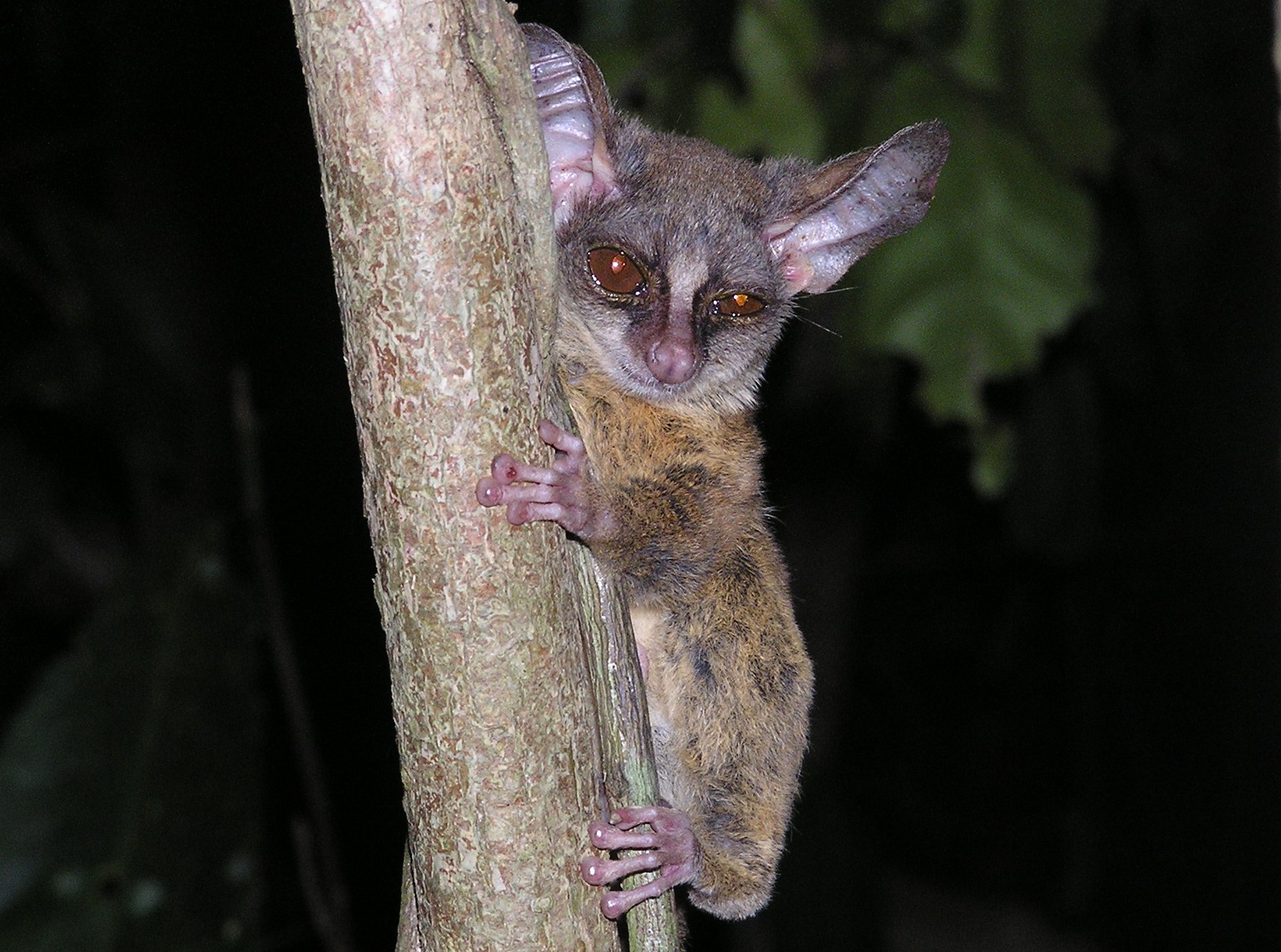- Many critically endangered species receive no conservation action because they are deemed ‘uncharismatic’ and fail to attract funding.
- Charisma challenged species are often small, less colorful, and little known to the public.
- Scientists have long argued that umbrella species protect uncharismatic species, but is that true?
This is part 1 of a series written by Mongabay columnist Jeremy Hance. Part 2 is here.
Meet the Tanzanian gremlin. Shhhhhh … though. She’s shy. But check out those bat-like ears. And those massive eyes. And that long scaly tail that ends in a flamboyant bush. And look how tiny she is: at around 100 grams (3.5 ounces) she’s the size of a newborn chihuahua. Yes, I know her name isn’t actually the Tanzanian gremlin, it’s the Rondo dwarf galago (Paragalago rondoensis). But I prefer gremlin. For one thing, let’s be honest, most of us probably don’t know what a galago is (it’s a primate in the suborder that includes lorises, lemurs and pottos) and gremlin is more evocative. Still, whatever her name is, isn’t she lovely?
Oh, did I mention? She’s critically endangered — and, at the moment, no one is working to save her.
She’s not alone. The Rondo dwarf galago, or the Tanzanian gremlin, is one of hundreds, if not thousands, of species already identified on the IUCN Red List as endangered or critically endangered that is receiving zero direct conservation attention or funding.
Little help for the charisma-challenged
“Large sections of the tree of life [are] completely absent from the conservation agenda,” says Olivia Couchman, the Zoological Society of London’s (ZSL) manager for its EDGE of Existence program.
The EDGE program, which stands for “evolutionarily distinct and globally endangered,” is a unique conservation program in that it seeks focal species not based on the potential for dollars raised or articles written or Instagram followers secured, but on the desire to preserve, as far as possible, distinct evolutionary branches that are in danger of being chopped off.

To do this, EDGE has created lists of the top 100 mammals, birds, amphibians and reptiles (as well as shorter lists for corals and sharks and rays) of the most evolutionarily distinct and endangered species: Basically, the world’s most unique species, often single members of an evolutionary line, that are imperiled with extinction.
“Charisma is subjective and even though EDGE species may not be traditionally charismatic there is nothing else like them on Earth, they are unique in the way they live, look and behave,” Couchman says.
To date, there isn’t much hard data on how many less-popular species lack direct conservation funding or assistance, but anecdotally, it’s a lot. The IUCN analyzes the conservation actions taken for each species, but using 12 criteria it can be difficult to ascertain the amount of attention paid to one animal versus another, especially en masse. The IUCN doesn’t categorize species based on level of action.
Still, to give us an idea, the EDGE program has labeled its 400-plus potential species under four straight-foward categories of conservation attention: very low, low, medium, and high.

“Our program has found that more than 70% of high-priority EDGE species are receiving insufficient conservation attention,” Couchman notes. “These species do not have an action plan, or it is very out of date, and receive very little or no research.”
Indeed, more than half of the EDGE mammals get low or very low attention — and that’s mammals. It’s worse for other types of animals. Forty-two percent of EDGE birds, 53% of amphibians, 62% of reptiles, and a whopping 67% of coral are categorized as receiving very low attention.
Such numbers give us a glimpse of how unbalanced conservation budgets are, focusing as they do mostly on the large, charismatic and cute species, while leaving many other species, including those on the edge of extinction, out in the cold.
There is a caveat to all this, and it’s not a good one. The EDGE list only looks at species that have been evaluated by the IUCN Red List — and that list is far from complete. In total, the IUCN Red List has only evaluated around 5% of described species, and these have largely focused on the more charismatic taxa. For example, while the IUCN has evaluated nearly 100% of the world’s birds and 90% of mammals, it has evaluated only 70% of the world’s reptiles, 10% of flowering plants, and less than 1% of its insects.
Who’s in and who’s out?
It’s not difficult to identify charismatic species. Just think of those animals that everyone is familiar with: tigers, elephants, lions, gorillas, pandas, humpback whales, etc.
“These tend to be species that feature in children’s story books … they are part of our upbringing even if found in countries thousands of miles away,” says Lesley Dickie, chief executive of the Durrell Wildlife Conservation Trust. Durrell is well-known in conservation circles for its laser-like focus on less-charismatic species.
Charismatic animals, not surprisingly, tend to get the bulk of direct conservation resources, funding and attention. Governments and conservation groups spend tens of millions of dollars on elephants, rhinos, pandas and a number of other charismatic heavy hitters. This isn’t a bad thing at all. Conservation efforts have saved a number of charismatic species not only from decline but total extinction: think of the European bison or the California condor. It’s hard to imagine tigers or pandas surviving the past hundred years without these massive conservation inputs.
But it does beg the question: Why them?
“I remember being on safari once and the whole jeep was full of people clambering to see a macerated, highly unattractive lion, while I was looking the other way at a stunning vulture in a tree very close by,” says Barney Long, the senior director of conservation at Global Wildlife Conservation, a group that has put a lot of funds and resources conserving more obscure species. “It was a great example of how certain species have become ingrained in people’s minds.”

Researchers told me that the hierarchy of charisma isn’t always simple, but it does follow a few general rules. Larger, “cuter” and more well-known animals obviously come out on top. Mammals are usually first, birds second. Land animals usually perform better than freshwater or marine.
But after this, it’s a bit of a toss-up. Reptiles, amphibians, fish — all of these struggle to break through. And insects, which data suggest are declining worldwide, prove an even harder sell.
There is complexity within taxonomic families, too. Mammals might get the most conservation attention, focusing mostly on big carnivores and primates, but rodents and bats get very little. Large reptiles, like some crocodiles, sea turtles and Komodo dragons, might receive attention, but small lizards or snakes largely linger in cashless obscurity. Pretty pollinators like butterflies and bees are getting some help and funds, but what about beetles and flies?
“Small brown frogs are not very popular,” says Couchman, summing up the struggles of the tiny and monochormatic.
Geography also plays a role, according to biologist Rebecca Stirnemann, who works in Samoa on several bird species close to extinction.
“Richer countries are more likely to fund their own endemic species over other countries’ endemics,” she says. But the vast bulk of the world’s species — and threatened species — live in the tropics, which are generally home to the more cash-strapped nations than the wealthier temperate countries.”
The GWC’s Long notes that one of the hardest groups to raise funds for are small rodents and rodent-like mammals, such as shrews and solenodons.

“Even though they are critical components of the ecosystem and many of them are both highly threatened and extremely charismatic, it is extremely hard to find people willing to support these efforts,” he says.
Few people had ever heard of the Bramble Cays melomy (Melomys rubicola), a small rodent, until it burst on the media scene in 2016. Why? It had been wiped out of existence by climate change.
Why are so many species getting so little?
It’s worth asking why this is: Why are so-called charismatic species receiving so much more funding than other species, including those that may be far closer to extinction?
Dickie with Durrell calls it a “numbers game.”
“More and more species are in decline and jumping into the categories of critically endangered or endangered and not enough of national budgets are available to conservation of species,” she says, adding that “species conservation is often seen as something that should be funded by charity … and not a component of essential care for the planet.”

Conservation and environmental protection worldwide is notoriously underfunded, lagging far behind other nonprofit causes even as global environmental crises continue to worsen. For example, according to Giving USA, charities supporting the environment or animals receive the least of any category.
Couchman says it’s also a matter of national wealth, pointing out that “almost all neglected EDGE species occur in low- or middle-income countries.”
Stirnemann agrees, adding that developing countries are not only able to give less, but also to support a species over time. “For instance, the kakapo in New Zealand has constant steady government support. Lesser-known species in developing countries get funds in an ad hoc fashion.”
This means even when lesser-known species get some funds or attention, it’s often for a short period of time and then vanishes again. Even then, the funds tend to focus on baseline research (since so little is known about the species) rather than actual conservation action.
“We find that a lack of awareness of the diversity of life on Earth hampers conservation efforts for lesser-known species rather than a lack of interest to conserve them,” Couchman says.
Hole in the umbrellas
Conservationists have long argued that saving charismatic species also conserves lesser-known ones. This is known as the umbrella species theory. In other words, protecting the tiger conserves its habit, safely ensures the survival of tens of thousands of other species that share that habitat.
This is true in some cases, but in an increasingly fragmented, threatened world — facing down things like climate change, the illegal wildlife trade, pollution, invasive species and ocean acidification — umbrella species may no longer protect as well as they used to.
“The habitat requirements for larger, more charismatic species do not always reflect the specific needs of highly specialized micro-endemics inhabiting specific habitats within a landscape, such as freshwater fish or stream-dependent frogs,” Couchman explains.
The umbrella species theory also undercuts the fact that many species now need action beyond simple habitat protection.
“This is most notably seen in species where specific disease risk is an issue, e.g. chytrid in amphibians … or where the driver of the decline is a specific illegal trade issue,” Dickie says.

There are also geographic issues. Some species survive in small fragmented areas with no charismatic species to draw attention or on islands without a charismatic magnet.
“[The umbrella strategy] assumes that all species occur in the same area, need the same resources, and that the threats are the same,” Stirnemann says. “But conservation management needs for various species can also vary a lot.”
She points to two birds that she works with in Samoa: the mao (Gymnomyza samoensis) needs rat control in its breeding habitat, while the manumea, or little dodo or toothbill pigeon (Didunculus strigirostris), requires control of feral cats, pigs and rats, as well as better-regulated hunting. Even though these two birds inhabit the same forests, they will need different strategies to survive this century. This will require “urgent funding attention,” according to Stirnemann.
Manifold species have no umbrella animals to take cover under. What big and brightly colored umbrella protects the mao and the little dodo? Or how about the Hispaniolan solenodon (Solenodon paradoxus)? Or the Mount Oku caecilian (Crotaphatrema lamottei)? Or even the Tanzanian gremlin?
Dickie calls the umbrella strategy a “false economy” because it ignores “the complexity of a community of species.”
She points to the recent reports of an insect apocalypse: declining insects means plummeting birds, mammals and flowers, regardless if the forest and charismatic animals are still protected.
Back to the Tanzanian gremlin
In many ways, the Rondo dwarf galago should be getting more attention. It’s a primate after all. It’s adorable. And it’s on the edge of extinction. But the lesson here is that even cute, critically endangered primates can perish in obscurity.
“Apart from projects geared toward habitat management, nobody is working on this species directly,” says Justine Gwegime. He spent two years, 2014-2016, working on the species as a fellow through the EDGE program.

Despite being a primate, the galago continues to fall through the cracks for a number of reasons: it’s small, hard to find, and lives in several disconnected dry forest patches.
During his time working on the species, Gwegime says the “main challenge” was getting the attention “of funders and other stakeholders.”
“In most cases they didn’t realize how conservation of this species will result in broader tangible impact to society,” he adds.
Gwegime says that today some of the forests remain “well protected” and populations in these forests may be on the rise.
“However, I’m worried about some areas where there is an increase in habitat destruction,” he notes.
The Rondo dwarf galago is just one of thousands, if not more, species whose existence is imperiled as much by its subjective lack of charisma as anything else. The question is, should conservation, which portrays itself as a science, be a popularity contest?
Read Part 2 of the series here.
